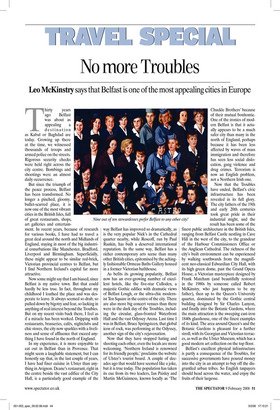No more Troubles
Leo McKinstry says that Belfast is one of the most appealing cities in Europe Thirty years ago Belfast was about as appealing a destination as Kabul or Baghdad are today. Growing up there at the time, we witnessed thousands of troops and armed police on the streets. Rigorous security checks were held right across the city centre. Bombings and shootings were an almost daily occurrence.
But since the triumph of the peace process, Belfast has been transformed. No longer a pinched, gloomy, bullet-scarred place, it is now one of the most vibrant cities in the British Isles, full of great restaurants, shops, art galleries and entertainment. In recent years, because of research for various books, I have had to travel a great deal around the north and Midlands of England, staying in most of the big industrial conurbations like Manchester, Bradford, Liverpool and Birmingham. Superficially, these might appear to be similar red-brick, Victorian provincial centres to Belfast, but I find Northern Ireland’s capital far more attractive.
Now some might say that I am biased, since Belfast is my native town. But that could hardly be less true. In fact, throughout my childhood I loathed the place and was desperate to leave. It always seemed so drab, so pulled down by bigotry and fear, so lacking in anything of real interest beyond the Troubles. But on my recent visits back there, I feel as if a miracle has been worked. Dripping with restaurants, brasseries, cafés, nightclubs and chic stores, the city now sparkles with a liveliness and sense of affluence that exceed anything I have found in the north of England.
In my experience, it is more enjoyable to eat out in Belfast than in Provence. That might seem a laughable statement, but I can honestly say that, in the last couple of years, I have had finer cuisine in Ulster than anything in Avignon. Deane’s restaurant, right in the centre beside the vast edifice of the City Hall, is a particularly good example of the way Belfast has improved so dramatically, as is the very popular Nick’s in the Cathedral quarter nearby, while Roscoff, run by Paul Rankin, has built a deserved international reputation. In the same way, Belfast has a richer contemporary arts scene than many other British cities, epitomised by the achingly fashionable Ormeau Baths Gallery housed in a former Victorian bathhouse.
As befits its growing popularity, Belfast now has an ever-growing number of excellent hotels, like the five-star Culloden, a majestic Gothic edifice with dramatic views of Belfast Lough, or the ultra-chic modernist Ten Square in the centre of the city. There are also more big concert venues than there were in the dark day of the Troubles, including the circular, glass-fronted Waterfront Hall and the vast Odyssey Arena. Last time I was in Belfast, Bruce Springsteen, that global icon of rock, was performing at the Odyssey, another sign of the city’s rejuvenation.
Now that they have stopped hating and shooting each other, even the locals are more welcoming. ‘Northern Ireland is renowned for its friendly people,’ proclaims the website of Ulster’s tourist board. A couple of decades ago that would have seemed like a joke, but it is true today. The population has taken its cue from its two leaders, Ian Paisley and Martin McGuinness, known locally as ‘The Chuckle Brothers’ because of their mutual bonhomie. One of the ironies of modern Belfast is that it actually appears to be a much safer city than many in the north of England, perhaps because it has been less affected by waves of mass immigration and therefore has seen less social dislocation, gang violence and drug crimes. Terrorism is now an English problem, not a Northern Irish one.
Now that the Troubles have ended, Belfast’s civic infrastructure has been revealed in its full glory. The city fathers of the 19th and early 20th centuries took great pride in their industrial might, and the result has been some of the finest public architecture in the British Isles, ranging from Belfast Castle nestling in Cave Hill in the west of the city, to the grandeur of the Harbour Commissioners Office or the Anglican Cathedral. The richness of the city’s built environment can be experienced by walking southwards from the magnificent neo-classical Edwardian City Hall, with its high green dome, past the Grand Opera House, a Victorian masterpiece designed by Frank Matcham (and beautifully restored in the 1980s by someone called Robert McKinstry, who just happens to be my father), then up to the Queen’s University quarter, dominated by the Gothic central building designed by Sir Charles Lanyon, and finally into the Botanic Gardens, where the main attraction is the sweeping cast-iron 1840s glasshouse, one of the finest examples of its kind. The area around Queen’s and the Botanic Gardens is pleasant for a further stroll, with its Georgian and Victorian terraces, as well as the Ulster Museum, which has a good modern art collection on the top floor.
Belfast’s excellent physical infrastructure is partly a consequence of the Troubles, for successive governments have poured money into the city in an attempt to buy off the disgruntled urban tribes. So English taxpayers should head across the water, and enjoy the fruits of their largesse.


































































 Previous page
Previous page